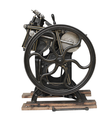Creating print artwork with Inkscape and Scribus
|
Most professional print products are created in Adobe's InDesign, Illustrator, and Photoshop products. However, the free Scribus [1] and Inkscape [2] application offer alternatives with which you can create technically flawless artwork for offset printing.
Sample CD Cover
Inkscape is still the most useful vector graphic program for design purposes. It provides a wide variety of tools and effects that give you the creative flow you need. You can also use it to integrate external bitmaps and texts.
Figure 1 shows the design for a CD cover in Inkscape. At the top, you can see the preparation for print setup that is used during the design for page size. The three millimeters wide red border is the so-called bleed that falls away during the sheet cutting. Because of the tolerances of the cutting machines, the design in this regard needs to proceed flawlessly.
[...]
Buy this article as PDF
Pages: 4
(incl. VAT)






